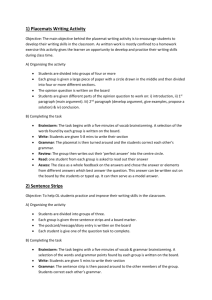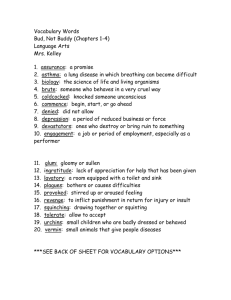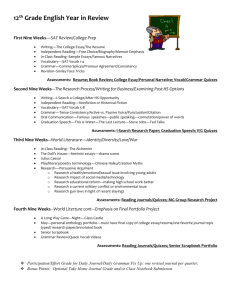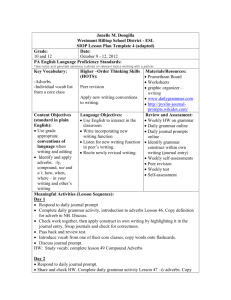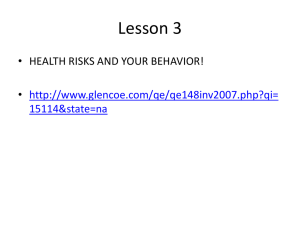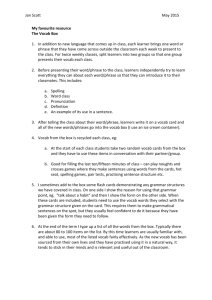Read the script from the Q&A session with Bob
advertisement
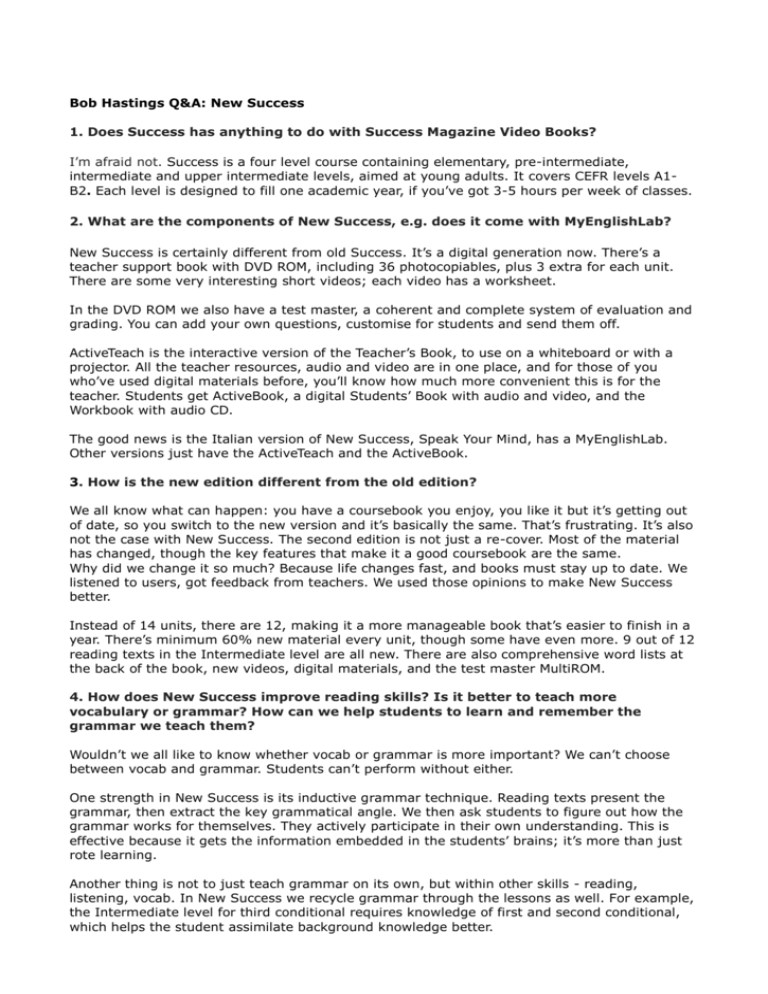
Bob Hastings Q&A: New Success 1. Does Success has anything to do with Success Magazine Video Books? I’m afraid not. Success is a four level course containing elementary, pre-intermediate, intermediate and upper intermediate levels, aimed at young adults. It covers CEFR levels A1B2. Each level is designed to fill one academic year, if you’ve got 3-5 hours per week of classes. 2. What are the components of New Success, e.g. does it come with MyEnglishLab? New Success is certainly different from old Success. It’s a digital generation now. There’s a teacher support book with DVD ROM, including 36 photocopiables, plus 3 extra for each unit. There are some very interesting short videos; each video has a worksheet. In the DVD ROM we also have a test master, a coherent and complete system of evaluation and grading. You can add your own questions, customise for students and send them off. ActiveTeach is the interactive version of the Teacher’s Book, to use on a whiteboard or with a projector. All the teacher resources, audio and video are in one place, and for those of you who’ve used digital materials before, you’ll know how much more convenient this is for the teacher. Students get ActiveBook, a digital Students’ Book with audio and video, and the Workbook with audio CD. The good news is the Italian version of New Success, Speak Your Mind, has a MyEnglishLab. Other versions just have the ActiveTeach and the ActiveBook. 3. How is the new edition different from the old edition? We all know what can happen: you have a coursebook you enjoy, you like it but it’s getting out of date, so you switch to the new version and it’s basically the same. That’s frustrating. It’s also not the case with New Success. The second edition is not just a re-cover. Most of the material has changed, though the key features that make it a good coursebook are the same. Why did we change it so much? Because life changes fast, and books must stay up to date. We listened to users, got feedback from teachers. We used those opinions to make New Success better. Instead of 14 units, there are 12, making it a more manageable book that’s easier to finish in a year. There’s minimum 60% new material every unit, though some have even more. 9 out of 12 reading texts in the Intermediate level are all new. There are also comprehensive word lists at the back of the book, new videos, digital materials, and the test master MultiROM. 4. How does New Success improve reading skills? Is it better to teach more vocabulary or grammar? How can we help students to learn and remember the grammar we teach them? Wouldn’t we all like to know whether vocab or grammar is more important? We can’t choose between vocab and grammar. Students can’t perform without either. One strength in New Success is its inductive grammar technique. Reading texts present the grammar, then extract the key grammatical angle. We then ask students to figure out how the grammar works for themselves. They actively participate in their own understanding. This is effective because it gets the information embedded in the students’ brains; it’s more than just rote learning. Another thing is not to just teach grammar on its own, but within other skills - reading, listening, vocab. In New Success we recycle grammar through the lessons as well. For example, the Intermediate level for third conditional requires knowledge of first and second conditional, which helps the student assimilate background knowledge better. There’s also the section called Mind the Trap. We all know, from long experience, the mistakes students will make before they make them. In New Success, we help them by warning them with Mind the Trap, so common mistakes are pre-empted. We know vocab is very important to read and use any language well, and there is lot of vocab in the lessons. Scrabble, ecology, crime, work, health, home; there’s every topic area you can image. There are also vocab exercises in almost all lessons: grammar vocab, speaking vocab, reading vocab etc. there’s lots of vocab content and lots of phrasal verbs and useful expressions. There are also word lists at the back of the book for students. 5. How are the four basic skills (reading, listening, writing and speaking) treated in the new book? What’s really important to help students be more effective? Give them something interesting to read. We’re proud of the reading texts in New Success because they motivate students, make them want to read. One of my favourites is a true story about an English guy who won a competition to be the caretaker of a tropical island, the ‘best job in the world’, tax free. There was quite a lot of publicity about that. We need interesting texts within which to demonstrate grammar and vocab so students understand, and we need to give them strategies for improving reading, in real life and exams. The Train Your Brain section does this. It helps students with strategies for embedding their skills. We show how to find specific information in the text, understand the main idea, predict what’s next, and repeat the main words. There are Train Your Brain sections for other fields as well. In terms of listening: one of the things I enjoy most about creating a series is that I have to go to the recording studio to help make audio recordings. It’s a great experience because the editors are so professional – it’s a real recording studio. More than anything, the actors are tremendous. I’m not sure how many of you have listened to The Archers, the longest running British radio show that I think goes back to the Second World War, but a lot of those actors do recordings for Pearson books including New Success. It sounds so natural. A lot of content in this series has a sense of humour, which is good. Train Your Brain is great for listening and writing as well. We had a lot of feedback on the writing content from the old edition. We now have Train Your Brain and comprehensive writing banks in the back of the Students’ Book. They’re wonderful; they show students how to structure their writing, e.g. what goes where? How do I get my point across effectively? They give alternative expressions, as well, that students can copy. It’s really holding them by the hand, giving them a lot of extra help. Even the weakest student manages to write simple texts effectively. As for speaking, the Speak Out feature in the Students’ Book covers every situation/function you could imagine, from expressing preferences to feelings, asking permission, making complaints, not only for real life but also for exams. There are special Speak Outs for exam orals. 6. How can I improve speaking with adult students? With adults, kids or adolescents, in my opinion, it’s the same problem: inhibitions prevent students from speaking. Confidence is an obstacle to speaking well. One of Speak Out’s main roles is to overcome that. It gives you a box with all the useful phrases your students need in all sorts of situations. Page 2 of 4 Page 4 Also, we’ve given students plenty of opportunity to talk about themselves. That really motivates people across the board. We get them to talk about their own lives, and give them a lot of guidance. They can use the Speak Out box to extract the words and phrases they need to complete the exercise. Then they can check their answers, and self-correct. Another example is asking when something unfair happened to you. Students need language, models, guidance, and personally relevant content. The best thing I’ve ever written is the series of DVD sketches in New Success. Do you ever use videos in your class? I’m not surprised that not everybody does; I know what it’s like sometimes. Either you play a video specifically for ELT, which is dull and unnatural, or you use authentic video from YouTube or similar, and it’s not relevant, so students lose interest. Our DVD sketches are short and simple and restricted to language from the Speak Out sections. I’m very proud of them – they’re funny, natural, short, and manage to restrict the language for that lesson. Students then feel they can really understand natural spoken English, which great for their confidence. Teachers have said they like the sketches on the DVD, and more importantly that the students like them. There are also worksheets in ActiveTeach with questions. 7. I’m sure a lot of teachers are concerned about making sure their students succeed in examinations. How does New Success prepare students for exams? There are comprehensive revision pages. After every two units, there’s a whole spread of revision. All skills are covered. To make life really easy, there’s a test master in the teacher MultiROM which is much more than just a collection of tests. The test master comes with a system of evaluating and grading for skills tests and oral exams. There are 12 presentations for each level, correlated to the units. There are 12 class projects, designed for small groups of 2-3 students. In Europe, in particular, we know it’s very important students are ready for oral examinations. There are oral sets to prepare students for oral exams, 12 topics at each level, 12 A/B language tests, 6 A/B skills tests, cumulative grammar and vocab tests, more tests than you’ll know what to do with! You’ll never run out of tests if you use New Success. The global version also has its inductive grammar approach. Repetition and Speak Out boxes are both good for exam technique. 8. How can I motivate my students so they succeed in learning English? How does New Success help teachers to motivate teenagers? We all know we need to motivate students, and it’s not easy. Students have to be interested. That’s a key word: interested. If students are intrigued by what they’re doing in class, they will learn more naturally, will be motivated to work harder and better. New Success is focused on making things interesting, in reading and listening particularly. We’ve tried to engage students, challenge them, intrigue them. There is content about cell phones, social media, stuff that’s personally relevant. We’re also not patronising them, which very often happens. We’re asking them to make their own choices, asking their opinions on issues like piracy and ethics; we’re treating them like intelligent young adults. Personal involvement is a great way to encourage motivation, and there are lots of examples and easy steps to follow so that even weaker students can do it. Often, the problem is not that they don’t know the language, grammar or vocab, but that they don’t know what to say. Not even in their own language. So, we’ve got to give them help. We have the Culture Shock sections: pages that provide cultural information on the back of each level. They show typical things British people say, for example; they’re funny spreads with cartoons that look at the literal meaning of idiomatic phrases. Page 3 Page 4 Laughter bonds people together – they become just a group of human beings instead of students and teacher. That’s exactly what we want in the classroom.
